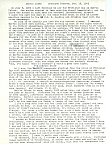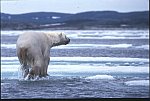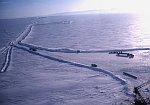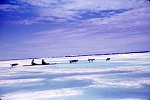Global Warming in the North:
Extreme Climate, Unpredictable Change
Author: Jennifer Jozic, Centre for Studies in Agriculture, Law and the Environment Page 1 | Page 2 | Page 3
Al Purdy, Canadian poet and dreamer, had dreamed of seeing the high North as a child in the 1920s. When he finally arrived in the North forty years ago, he was thrilled to find much of the Arctic exactly as he had envisioned it. “The true north strong and choked with ice,” is how he described the village of Pangnirtung in his diary, and he enthused about his opportunity to “drift with the tides on Cumberland Sound and its blue fiord, [where] bergs and growlers are always in sight, even at the height of summer. They range in size all the way from bucket sized ice cubes too large for a martini, to bergs a couple of hundred feet across.”
The Arctic will continue to provide experiences very similar to Purdy’s in landscapes full of icy expanses and cool northern seas. However, during the last several decades the climate in the region has begun to change. Familiar cold weather characteristics are giving way to warmer, more problematic environmental conditions. Melting permafrost and erratic seasonal changes are straining transportation systems and threatening the livelihoods of residents.
The changing climate is rapidly altering the North and all predictions seem certain that the trends will continue for at least the next few decades. Seasonal ice may soon disappear from Hudson's Bay creating a viable Northwest Passage. There is some historical irony that Nature might soon provide what was so ardently sought by European adventurers over three centuries ago. Global weather systems that have depended on the Arctic to “refrigerate” and sink salt water and carbon dioxide are also likely to be affected. The magnitude of these changes has not yet been comprehended.
The Inuit, however, are acutely aware of the irrevocable changes occurring in their homeland. The lifestyle of the Inuit is based on traditional activities and is characterized by co-existing with extreme, but predictable, conditions. Arctic warming is making Inuit lives unpredictable and their small communities may, in fact, be faced with having certainty disappear altogether.
Transportation by land is becoming increasingly difficult. Snowmobiles and dog sleds are reliable in cold weather conditions but cannot function well in a wet and muddy environment. Hunting generally requires the presence of some ice because predators, both human and animal, use floating ice as a platform to obtain their aquatic prey. Even tourism requires a certain level of “frostiness” because visitors such as Al Purdy arrive expecting to see trademark wildlife such as polar bears, walrus and seals.
Seasonal Variety in the Arctic
The Arctic has two relatively warm seasons and two extremely cold seasons. Even the warm seasons do not offer the same kind of temperatures that are expected in the south and it rarely becomes warm enough to wear short sleeves anywhere in the Arctic or sub-arctic. This is because the angle of sunlight is more pronounced, resulting in weaker rays.
Spring arrives with the break-up of the ice and the return of migratory birds from the south. During the warm seasons large quantities of surface water appear as a result of melting snow. The newly formed water percolates through the active layer of the surface but is unable to penetrate into the permafrost. Since the water cannot be absorbed the pools of water form on the surface. Arctic summer supports a greater variety of wildlife and travel by boat becomes possible. Tundra vegetation flourishes and a large number of insects emerge in the marshlands.
With climate change the warm seasons are becoming longer, and more high latitude storms are occurring because average sea level pressure has dropped over the central Arctic Ocean. Air masses from the Arctic coast are melting sections of sea ice and are driving much of the remainder away from the shore.
The warming climate has made the transitional periods between seasons longer, more pronounced, and very difficult to cope with. Melting permafrost and occasional thunderstorms (a relatively new phenomenon so far north) are creating muddy landscapes which destroy roads, damage vehicles and remove the habitat of rodents that were previously able to burrow into the permafrost.
In the past two decades:
- The melt season has varied between 55-75 days
- The melt season has lengthened at a rate of 5.3 days, or 8%, per decade
- Leads (cracks) have opened in the ice
- Leads reflect less sunlight, warming and thus melting still more ice
In contrast the cold seasons are becoming shorter and less extreme. Autumn in the Arctic is prime hunting season for northern residents. At this time animals like polar bears and caribou have ‘fattened up’ for the winter, providing greater returns on meat than if they were caught during the spring and summer. Fall, with its relatively short length and lower temperatures, quickly gives way to winter. South of the tree line winter is noted for its inconveniences such as the need to clear roads and heat houses, but in the Arctic winter is associated with certain advantages. Ice becomes available for household use and ice roads can be constructed for vehicle transport. Residents are able to move around by skidoo and, occasionally, by dogsled.
Scientists continue to track the impact these changes have made on Arctic flora and fauna such as ice algae, walrus and polar bear populations. They are maintaining dialogue with Arctic residents about their observations and experiences.









